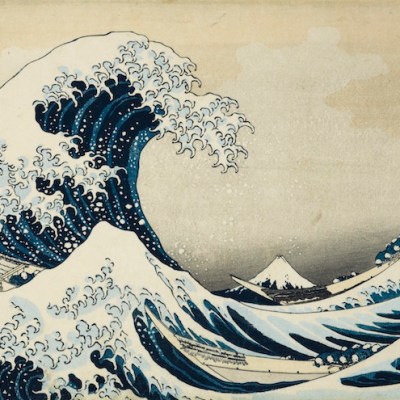If I asked you to name the most famous Japanese artist, the chances are you would answer either Yayoi Kusama or Hokusai. The latter, well known for his celebrated print The Great Wave, was born in Edo (present-day Tokyo) in 1760. Yet, until recently, no institution in the capital was dedicated to Hokusai, one of Tokyo’s best-loved sons and a remarkably prolific and original artist. After 20 years of planning, the Sumida Hokusai Museum finally opened its doors to the public in November 2016. The museum is run by Tokyo’s Sumida ward and is situated in the north-eastern part of the city, where Hokusai spent most of his life. The artist, who is said to have moved more than 90 times, mainly around this area, would not recognise it today; traces of the past are scarce, replaced by office and apartment buildings.
Intended as a new cultural landmark for the district, the museum was built in a public park but space was limited both on the ground and vertically, as the municipality had to keep an open square and playground in front, and respect height regulations. The architect Kazuyo Sejima has created a striking building with angular cuts and a subtly reflective façade that seems to melt into its surroundings. Triangular apertures cut the structure into four parts at ground level, allowing passers-by to walk freely through it and visitors to access the entrance from all directions.
Rainstorm Beneath the Summit, from Thirty-six Views of Mount Fuji (1831–32), Katsushika Hokusai. Sumida Hokusai Museum, Tokyo

A visit to the museum begins on the top floor, with a permanent display that traces Hokusai’s long career – the artist died in 1849 at the age of 90 and worked until the end. It is a little puzzling at first to realise that all the works in this gallery are replicas. The museum’s approach arises from conservation issues: showing the original works, all light-sensitive and executed on paper or silk, would have meant changing the display entirely every month (the high-quality replicas on view have been printed digitally on washi paper or silk, a lengthy process that began in 2013). The presentation is chronological, starting with Hokusai’s early prints of actors and landscapes that show the influence of Western-style perspective. Having achieved some success, Hokusai began to produce still-life surimono, privately commissioned luxurious prints, under the name of Sori; throughout his career he often changed his signature, to reflect new departures in his life and art (he would call himself ‘old man crazy about painting’ in later years).
Hokusai illustrated books, from Chinese historical literature to contemporary novels, and he also published numerous sketchbooks, or manga, on a range of subjects. Between 1831 and 1832, when he was in his seventies, Hokusai created Thirty-six Views of Mount Fuji, which captures the mountain in different atmospheric conditions and from a variety of vantage points. A brilliant example of his inventiveness, the series was incredibly successful in his lifetime. During his last decade he devoted himself to painting and produced meticulous pictures for wealthy patrons. The museum’s life-size reproduction of the artist’s workshop features an aged Hokusai and his daughter Eijo, an accomplished artist in her own right, who assisted him in his work during his late years.
Digital screens placed near the works provide information in several languages and interactive tools allow visitors to flip through an entire book, or zoom into the smallest details of a print. The design of the permanent gallery was decided by the museum, not the architect, and even though the replicas are not light-sensitive, it features black walls and moody lighting; blue lights running along the floor are intended to evoke the Sumida river that flows nearby.
The permanent display in the Sumida Hokusai Museum traces Hokusai’s long career. © Forward Stroke

In contrast, the other spaces, conceived by Kazuyo Sejima, are light and airy with pale colours, wooden floors and clean lines. The cityscape appears through the slits in the building’s façade, but it is otherwise windowless to protect the artworks. Two galleries dedicated to special exhibitions are connected by a graceful helicoid staircase. These may focus on a particular period in Hokusai’s career, or one of his favoured themes; at the time of my visit the show was ‘A Ramble down the Tōkaidō Road – Travelling with Hokusai along the Fifty-Three Stations’. In this series of prints, Hokusai captured everyday scenes along the main road connecting Edo to Kyoto. In these galleries, it is a pleasure to admire original works by the master, delight in the subtleness of colours, and the excellent condition of the woodblock prints.
Collecting began some 20 years ago and the museum now holds around 1,800 works, mostly by Hokusai but also by his pupils. Owing to Hokusai’s great versatility, there are woodblock prints, illustrated books, drawings, handscrolls, and hanging scrolls on silk. Many of these come from the collections of the late American collector Peter Morse, as well as that of Narazaki Muneshige, who was regarded as one of Japan’s leading experts on ukiyo-e (‘pictures of the floating world’).
Two recent and very successful exhibitions in Europe – the 2014–15 retrospective at the Grand Palais, Paris, and the captivating exhibition held earlier this year at the British Museum – attest to Hokusai’s widespread appeal. Interest in the artist is not new; his reputation spread quickly just years after his death. A volume of Hokusai’s Sketches (Hokusai Manga) found its way into the Bibliothèque nationale in Paris as early as 1843, and the British Museum purchased its first Hokusai print in 1860. His work captivated Western artists and provided seminal inspiration to the Japonisme movement.
The Sumida Hokusai Museum is set to attract local and foreign visitors alike for years to come. It is exciting to note that Yayoi Kusama, mentioned at the opening of this letter, is not to be outdone: she opened her own museum in Tokyo in early October.
From the November 2017 issue of Apollo: preview and subscribe here.


